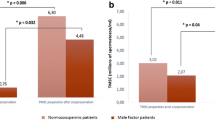Abstract
Purpose: Our purpose was to evaluate sperm motility and viability and the maintenance of these parameters in already cryopreserved semen samples following repeated freezing/thawing cycles.
Methods: Human spermatozoa were subjected to five cycles of cryopreservation/thawing. Recovery of sperm motility and viability and the proportion of viable nonmotile sperm were determined up to 6 hr after thaw.
Results: Sperm motilities (prefreeze motility, 70.1%; n = 9 samples) after each of five freeze/thaw cycles were 24.4, 8.0, 3.5, 1.5, and 1.8%. The recovery of sperm viability was higher than that of motility after each cycle: 39.1, 25.3, 22.6, 17.8, and 16.5%. Recoveries of motility and viability were improved if the thawed samples were left in the original cryopreservation medium prior to refreezing vs. if a washing/resuspension step was included. The recovery of sperm motility in the first thawing cycle was indicative of the expected motile sperm recovery in the second thawing cycle.
Conclusions: Cryopreserved semen that is intended to be reused in future assisted reproduction treatments should be thawed only once and aliquoted in the original freezing medium before refreezing. The recovery of sperm motility and viability in the second thawing cycle, thus the applicability of the sample in conventional in vitro fertilization or intracytoplasmic sperm injection may be anticipated in >90% of the samples. In view of intracytoplasmic sperm injection it is important that sperm viability is maintained better than motility; after the first, second, and third thawing cycles the ratios of motile:nonmotile viable sperm were 1:1, 1:4, and 1:7, respectively.
Similar content being viewed by others
REFERENCES
Sherman JK: Freezing and freeze-drying of human spermatozoa. Fertil Steril 1954;5:357–371
McGann LE: Differing actions of penetrating and nonpenetrating cryoprotective agents. Cryobiology 1978;15:382–386
Serres C, Jouannet P, Czyglic F, David G: Effects of freezing on spermatozoa motility. In Human Artificial Insemination and Semen Preservation, G David, WS Price (eds). New York, Plenum Press, 1980, pp 147–161
Henry MA, Noiles EE, Gao D, Mazur P, Critser JK: Cryopreservation of human spermatozoa. IV. The effects of cooling rate and warming rate on the maintenance of motility, plasma membrane integrity, and mitochondrial function. Fertil Steril 1993;60(5):911–918
Keel BA, Webster BW, Roberts DK: Effects of cryopreservation on the motility characteristics of human spermatozoa. J Reprod Fertil 1987;81:213–220
Critser JK, Arneson BW, Baker DV, Huse-Benda AR, Ball GD: Cryopreservation of human spermatozoa. II. Postthaw chronology of motility and of zona-free hamster ova penetration. Fertil Steril 1987;47:980–984
Kolon TF, Philips KA, Buch JP: Custom cryopreservation of human semen. Fertil Steril 1992;58:1020–1023
Keel BA, Webster BW: Semen analysis data from fresh and cryopreserved donor ejaculates: Comparison of cryoprotectants and pregnancy rates. Fertil Steril 1987;52:100–106
La Lanou D, Gastard D, Guivarch A, Laurent MC, Poulain P: Strategies in frozen donor semen procreation. Hum Reprod 1995;10:1765–1774
Critser JK, Huse-Benda AR, Aaker DV, Arneson BW, Ball GD: Cryopreservation of human spermatozoa: 1. Effects of holding procedure and seeding motility, fertilizability and acrosome reaction. Fertil Steril 1987;47:656–663
Richter A, Haning V, Shapiro SS: Artificial donor insemination. Fresh versus frozen semen: The patient as her own control. Fertil Steril 1984;41:277–281
Hammond MG, Jordan S, Sloan CS: Factors affecting pregnancy rates in a donor insemination program using frozen semen. Am J Obstet Gynecol 1986;155:480–484
Mahadevan M, Trounson A: Effect of cryoprotective media and dilution methods on the preservation of human spermatozoa. Andrologia 1983;15:355–360
Critser JK, Huse-Benda AR, Aaker DV, Arneson BW, Ball GD: Cryopreservation of human spermatozoa. III. The effect of cryoprotectants on motility. Fertil Steril 1988;50:314–320
Verheyen G, Pletincx I, Van Steirteghem A: Effect of freezing method, thawing temperature and post-thaw dilution/washing on motility (CASA) and morphology characteristics of high-quality human sperm. Hum Reprod 1993;8(10):1678–1684
Davis RO, Drobnis EZ, Overstreet JW: Application of multivariate cluster discriminate function, and stepwise regression analyses to variable selection and predictive modeling of sperm cryosurvival. Fertil Steril 1995;63:1051–1057
Garner DL, Johnson LA: Viability assessment of mammalian sperm using SYBR-14 and propidium iodide. Biol Reprod 1995;53(2):276–284
Leffler KS, Walters CA: A comparison of time, temperature, and refreezing variables on frozen sperm motility recovery. Fertil Steril 1996;65:272–274
Aitken RJ, Krausz CS, Buckingham D: Relationship between biochemical markers for residual sperm cytoplasm, reactive oxygen species generation, and the presence of leukocytes and precursor germ cells in human sperm suspensions. Mol Reprod Dev 1994;39:268–279
Huszar G, Corrales M, Vigue L: Correlation between sperm creatine phosphokinase activity and sperm concentrations in normospermic and oligospermic men. Gamete Res 1988;19:67–75
Huszar G, Vigue L: Incomplete development of human spermatozoa is associated with increased creatine phosphokinase concentration and abnormal head morphology. Mol Reprod Dev 1993;34:292–298
Huszar G, Sbracia M, Vigue L, Miller D, Shur B: Sperm plasma membrane remodeling during spermiogenetic maturation in men: Relationship among plasma membrane beta-1,4-galacto-syltransferase, cytoplasmic creatine phosphokinase, and creatine phosphokinase isoform ratios. Biol Reprod 1997;56:1020–1024
Huszar G, Vigue L: Correlation between the rate of lipid peroxidation and cellular maturity as measured by creatine kinase activity in human spermatozoa. J Androl 1994;15:71–77
Author information
Authors and Affiliations
Rights and permissions
About this article
Cite this article
Polcz, T.E., Stronk, J., Xiong, C. et al. Optimal Utilization of Cryopreserved Human Semen for Assisted Reproduction: Recovery and Maintenance of Sperm Motility and Viability. J Assist Reprod Genet 15, 504–512 (1998). https://doi.org/10.1023/A:1022586505089
Issue Date:
DOI: https://doi.org/10.1023/A:1022586505089




